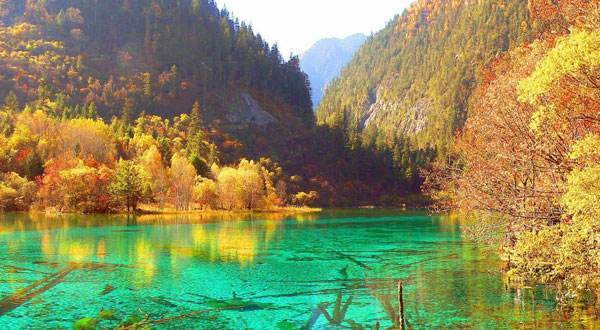Ruoergai Grassland
Ruoergai Grassland is a must-visit spot for self-driving tours. It is like a magnificent emerald embedded on the northwestern border of Sichuan, known as the 'Oasis of the Northwestern Sichuan Plateau' and is one of the three major wetlands in China. The sky is high and clear, with very high visibility. Between heaven and earth, the green grass is lush, the flowers are blooming, and the fragrance is faint, stretching as far as the eye can see. The grassland is dotted with countless small lakes, the water is blue, and small rivers like vines connect the lakes of various sizes. The river water is crystal clear, and fish can be seen swimming. Additionally, every mid-September, the mountains are covered with red leaves, creating a distinct layering from the top of the mountain to the river valley. Walking in the corridor where the green of the river valley and the colorful mountains intertwine, your heart will be filled with the intoxicating colors of autumn.
The beauty of Labrang Monastery lies not only in its magnificent golden halls, imposing Buddha statues, incense-filled Sang incense burners, colorful prayer flags, and densely packed grand buildings, but also in its profound history and religious charm. Driving to Labrang Monastery, one can feel the enduring charm of faith through the thick Sang smoke, the ever-burning butter lamps, the endlessly turning prayer wheels, and the devout pilgrims performing full-body prostrations. Labrang Monastery is one of the pilgrimage sites for the Tibetan people.
Entering through the gate of Songzhou Ancient City, you will find bustling streets outside the gate. At the entrance of the ancient city stands the lifelike statues of Princess Wencheng and Songtsen Gampo. Inside the gate is the interior of the ancient city, with a small square nearby that houses many sculptures, including figures dressed in Han and Tang dynasty attire and scenes depicting the tea-horse trade between the Han and ethnic minorities. Further inside is a folk commercial street lined with shops offering a wide variety of Tibetan specialties and handicrafts. The architecture predominantly features Han and Tang styles. Continuing south, you will cross the ancient Song corridor bridge, under which clear water flows, creating a cool breeze and a unique landscape.
Chuanzhusi
Chuanzhusi is located at the crossroads of four highways: Songpan, Hongyuan, Jiuzhai, and Huanglong, making its geographical location very advantageous. It is 39 kilometers east of the Huanglong Scenic Area, 87 kilometers north of the Jiuzhaigou Scenic Area, 40 kilometers west of the Hongyuan Grassland, and 17 kilometers south of the ancient city of Songpan. It is a must-pass place for self-driving tours to Jiuzhai and Huanglong.
Muni Valley Scenic Area
Muni Valley is located in Songpan County, Aba Tibetan and Qiang Autonomous Prefecture, Sichuan Province, more than 300 kilometers away from Chengdu. It covers an area of 160 square kilometers, with the highest altitude of 4070 meters and the lowest altitude of 2800 meters. Muni Valley is a favored place. Like other scenic spots, the scenery of Muni Valley in spring, summer, autumn, and winter has its own charm. Only by being there in person can one enjoy the picturesque beauty.
Dayu National Forest Park
Dayu National Forest Park belongs to the primeval forest of the Di Mountain Range, with the highest altitude of 4920 meters and the valley entrance at 2500 meters. There are more than ten deep gorges with cuts exceeding a thousand meters. The vegetation in the scenic area shows significant vertical zonation differences. Above the snow line in the middle of the mountain are bare rocks, followed by alpine meadows, primeval forests, low mountain meadows, shrubs, and rural farmlands. Some areas are rarely visited by people.















